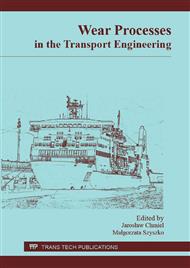[1]
CONCRETE. The practical guide by the company Sika® (in polish).
Google Scholar
[2]
Concrete by Polish Norm PN-EN 206: 2014, Communicant of the company Góradże Heidelberg Cement Group (in polish).
Google Scholar
[3]
R. Cieślik, Selected issues of operating durability and wear in the transport chain of the concrete mixtures, Maritime University of Szczecin, Engineering Diploma Work by supervision of Jarosław Chmiel, (2012) (in polish).
Google Scholar
[4]
Z. Jamroży, Concrete and its technologies. Warsaw, PWN, the third edition (2006) (in polish).
Google Scholar
[5]
T. Kijowska , Concrete worker, KaBe, Krosno (2007) (in polish).
Google Scholar
[6]
M. Piotrowski, Logistics of production and distribution of concrete mixtures, Maritime University of Szczecin, Engineering Diploma Work by supervision of Małgorzata Szyszko (2015) (in polish).
Google Scholar
[7]
PN-EN 206: 2014, Concrete - Specification, performance, production and conformity, (in polish).
Google Scholar
[8]
Z. Sikora, Concrete plants - construction, operation, technology works, KaBe, Krosno (2013) (in polish).
Google Scholar
[9]
B. Stefańczyk (joint publication), Building Industry, Volume 1, materials and construction products, Warsaw, Arkady, (2005) (in polish).
Google Scholar
[10]
O.I. Balyts'kyi, V.O. Kolesnikov:, Investigation of wear products of high-nitrogen manganese steels, Materials Science (Springer). – 2009, vol. 45, N 4. - P. 576-581.
DOI: 10.1007/s11003-010-9216-1
Google Scholar
[11]
O.I. Balyts'kyi, V.O. Kolesnikov, P. Kawiak P. Triboengineering properties of austenitic manganese steels and cast irons under the conditions of sliding friction, Materials Science (Springer) – 2005, vol. 41, No 5. - P. 624 –630.
DOI: 10.1007/s11003-006-0023-7
Google Scholar
[12]
O.I. Balyts'kyi, V.O. Kolesnikov:, Investigation of wear products of austenitic manganese cast-iron, Materials Science (Springer). - 2004, vol. 40, No 1. - P. 78 – 82.
DOI: 10.1023/b:masc.0000042788.19429.a1
Google Scholar
[13]
A.I. Balitskii, V.O. Kolesnikov, J. Chmiel J., The influence of microstructure and hydrogen-containing environment on the intensity of cast iron and steel damage by sliding friction. Part 1. The construction of a generalized model of surface layer friction of graphitized steel and cast-iron objects. Problemy eksploatacji (Maintenance Problems), nr 4/2007 (67), ISSN 1232-9312, s. 17-30.
Google Scholar
[14]
A.I. Balitskii, V.O. Kolesnikov, J. Chmiel, Influence of the cast-iron and steel microstructure and hydrogen containing environments on the destruction intensity during sliding friction. Part 2. Generalized model of steels and grey-iron behaviour during sliding friction. Problemy eksploatacji (Maintenance Problems) nr 3/2008 (70), ISSN 1232-9312, s. 91-102.
Google Scholar
[15]
A.I. Balitskii, I. Ripey, J. Chmiel, Deposit Attack In Tubes Of Power Plant Steam Boilers, Problemy eksploatacji (Maintenance Problems) nr 4/2010 (79) s. 79-90 ISSN 1232-9312.
Google Scholar


